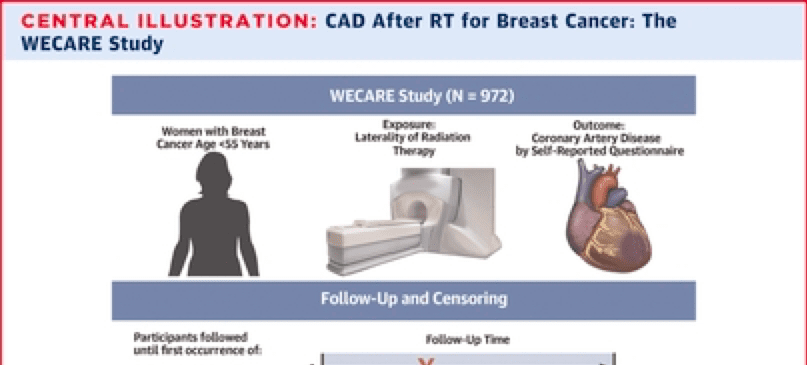By LE Carlson et al. Taken directly from JACC
Radiation therapy (RT) for breast cancer increases risk of coronary artery disease (CAD). Women treated for left- vs right-sided breast cancer receive greater heart radiation exposure, which may further increase this risk.
The purpose of this study was to report CAD risk amongst younger breast cancer survivors that participanted in the Women’s Environmental Cancer and Radiation Epidemiology Study.A total of 1,583 women who were <55 years of age when diagnosed with breast cancer between 1985 and 2008 completed a cardiovascular health questionnaire. Risk of radiation-associated CAD was evaluated by comparing women treated with left-sided RT with women treated with right-sided RT using multivariable Cox proportional hazards models. Effect modification by treatment and cardiovascular risk factors was examined.

In total, 517 women who did not receive RT and 94 women who had a pre-existing cardiovascular disease diagnosis were excluded, leaving 972 women eligible for analysis. Their median follow-up time was 14 years (range 1-29 years). The 27.5-year cumulative incidences of CAD for women receiving left- vs right-sided RT were 10.5% and 5.8%, respectively (P = 0.010). The corresponding HR of CAD for left- vs right-sided RT in the multivariable Cox model was 2.5 (95% CI: 1.3-4.7). There was no statistically significant effect modification by any factor evaluated.
Young women treated with RT for left-sided breast cancer had over twice the risk of CAD compared with women treated with RT for right-sided breast cancer. Laterality of RT is independently associated with an increased risk of CAD and should be considered in survivorship care of younger breast cancer patients.
Limitations:
- Detailed cardiac dosimetry not available therefore, used laterality of radiotherapy as a proxy for increased radiation dose received to the heart.
- Cardiovascular disease was self-reported and was not verified overall through medical record review.
- Unable to rule out the possibility of selection bias
- Information on RT planning methods for cardiac dose sparing was not collected.
- Modern breast cancer RT planning includes cardiac dose sparing techniques such as prone positioning, breath hold techniques, and proton beam therapy, which reduce radiation dose to the heart. Therefore, women treated for breast cancer incorporating these contemporary RT techniques will likely have a lower risk of CAD compared with that seen in this study, as the majority of participants were diagnosed with breast cancer before these techniques were introduced or commonly in use.
Read full article: https://www.jacc.org/doi/10.1016/j.jaccao.2021.07.008
Read related editorial: https://www.jacc.org/doi/10.1016/j.jaccao.2021.08.002
Listen to the podcast: https://www.jacc.org/do/10.1016/podcast-jco-3-3-1/full/
References:
Carlson LE , Watt GP, Tonorezos ES, Chow EJ, Yu AF, Woods M,et al. Coronary Artery Disease in Young Women After Radiation Therapy for Breast Cancer: The WECARE Study. J Am Coll Cardiol CardioOnc. 202; 3(3): 381–392

